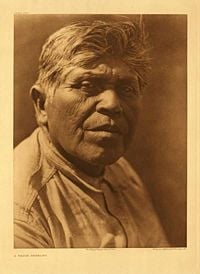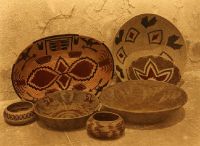Difference between revisions of "Serrano (people)" - New World Encyclopedia
| Line 58: | Line 58: | ||
* Mount, Guy. 1993. ''Serrano Songs and Stories''. Sweetlight Books, Cottonwood, California. | * Mount, Guy. 1993. ''Serrano Songs and Stories''. Sweetlight Books, Cottonwood, California. | ||
| + | * Edwards, Andrew. 2006. [http://www.sbsun.com/search/ci_4780412 Saving the Serrano tongue]. ''The Sun: San Bernadino and the Inland Empire''. Retrieved October 16, 2008. | ||
==External links== | ==External links== | ||
Revision as of 23:13, 16 October 2008
The Serrano are a Native American tribe of Southern California. They refer to themselves as the Yuhaviatam, which means "people of the pines."
History
Estimates for the pre-contact populations of most native groups in California have varied substantially. (See Population of Native California.) Alfred L. Kroeber (1925:617, 883) put the combined 1770 population of the Serrano, Kitanemuk, and Tataviam at 3,500 and the Serrano proper (excluding the Vanyume) at 1,500. Lowell John Bean suggested an aboriginal Serrano population of about 2,500 (Bean and Smith 1978:573).
Kroeber estimated the combined population of the Serrano, Kitanemuk, and Tataviam in 1910 as 150.
Members of the Serrano tribe are part of the Shoshonean subset of the Uto-Aztecan group of Native Americans. Serrano means highlander. They were an offshoot of the Takic people that arrived in Southern California around 2,500 years ago. When the Spanish missionaries came into the region, they helped form the tribal name Serrano, separating them from their neighbors that were designated as the Gabrielino and Kitanemuk.
San Bernardino's earliest known inhabitants were Serrano Indians (Spanish for "people of the mountains") who spent their winters in the valley, and their summers in the cooler mountains. They were known as the "Yuhaviatam" or People of the Pines. They have lived in the valley since approximately 1000 B.C.E. They lived in small brush covered structures. At the time the Spanish first visited the valley, approximately 1500 Serranos inhabited the area. They lived in villages of ten to thirty structures that the Spanish named rancherías.
The Serrano historically populated the San Bernadino Mountains and extended down to the Mojave River region down to the Tejon Creek.
The populations along the Tejon Creek identified their tribes as the Cuahajai or Cuabajay. Their dwellings were communal and made of willow framing. The dwellings were complete with fireplaces for each family and they crafted baskets and vessels with mother-of-pearl inlays which were often traded to the native people in the Santa Barbara region. The men did not wear clothing and the women wore deerskin, otter, and rabbit furs.
The Serrano that inhabited the San Bernadino mountains would go to the valleys of Apple Valley and Lucerne during the winter and the area in and around Big Bear Lake during the summer. They hunted small game like rabbits utilizing traps along with bows and arrows. They did not hunt the Grizzly Bears which they believed were reincarnations of their ancestors spirits. They were skilled craftsmen, experts in basketweaving. Their diet consisted of the game that they caught as well as pinon nuts ground into a dough and made into a flat tortilla like food. They also ate the acorns from the oak trees to make a flour and then porridge called wiich. Other staples were roasted agave, prickly pears, and Yucca blossoms.
Mission San Gabriel Arcangel was founded in 1771 and the Serrano revolted against the missions along with the Cahuilla and Yuma tribes in 1812. In 1834 many Serrano were forcibly relocated to the missions. They suffered devastating smallpox outbreaks in both 1840 and 1860 before a reservation was established in 1875.
In 1866, militia forces from San Bernardino killed Serrano men, women, and children in a 32-day campaign. Yuhaviatam tribal leader Santos Manuel (from whom the name "San Manuel comes)led the remaining Yuhaviatam from the mountains to valley floor.
Other villages of the Serranos included Akxawiet, Cucamonga, Homhoabit, Jurumpa, Juyubit, Muscupiabit, San Benito, San Gorgonio, San Pascual, Tolocabi, and Yucaipa.
Culture
Mythology
Serrano traditional narratives include myths, legends, tales, and oral histories preserved by the Serrano people of the San Bernardino Mountains and southern Mojave Desert of southern California.
Serrano oral literature is closely linked with the traditions of the Serrano's closest linguistic relatives, the Takic-speaking groups to their south, as well as with the traditions of the Yuman-speaking groups. These relationships are particularly evident in the sharing of the distinctive Southern California Creation Myth.
Arts
Serrano are skilled at basketweaving.
Contemporary Serrano
The current reservations for the Serrano are the Morongo Band of Mission Indians in Banning, California and the San Manuel Band of Mission Indians in Highland, California.
ReferencesISBN links support NWE through referral fees
- Bean, Lowell John, and Charles R. Smith. 1978. "Serrano" In California. Edited by Robert F. Heizer. pp. 570-574. Handbook of North American Indians. William C. Sturtevant, general editor. Vol. 8. Smithsonian Institution, Washington, D.C.
- Kroeber, A. L. 1925. Handbook of the Indians of California. Bureau of American Ethnology Bulletin No. 78. Washington, D.C.
- Waldman, Carl. 2006. Encyclopedia of Native American Tribes. New York, NY: Checkmark Books. ISBN 978-0816062744
- Benedict, Ruth. 1926. "Serrano Tales." Journal of American Folklore 39:1-17. (17 myths narrated by Rosa Morongo.)
- Gifford, Edward Winslow. 1918. "Clans and Moieties in Southern California." University of California Publications in American Archaeology and Ethnology 14:155-219. Berkeley. (Myths narrated by Benjamin Morongo in 1916-1917, pp. 182-186.)
- Margolin, Malcolm. 1993. The Way We Lived: California Indian Stories, Songs, and Reminiscences. First edition 1981. Heyday Books, Berkeley, California. (Orpheus myth, pp. 82-83, from Benedict 1926.)
- Mount, Guy. 1993. Serrano Songs and Stories. Sweetlight Books, Cottonwood, California.
- Edwards, Andrew. 2006. Saving the Serrano tongue. The Sun: San Bernadino and the Inland Empire. Retrieved October 16, 2008.
External links
Credits
New World Encyclopedia writers and editors rewrote and completed the Wikipedia article in accordance with New World Encyclopedia standards. This article abides by terms of the Creative Commons CC-by-sa 3.0 License (CC-by-sa), which may be used and disseminated with proper attribution. Credit is due under the terms of this license that can reference both the New World Encyclopedia contributors and the selfless volunteer contributors of the Wikimedia Foundation. To cite this article click here for a list of acceptable citing formats.The history of earlier contributions by wikipedians is accessible to researchers here:
The history of this article since it was imported to New World Encyclopedia:
Note: Some restrictions may apply to use of individual images which are separately licensed.

